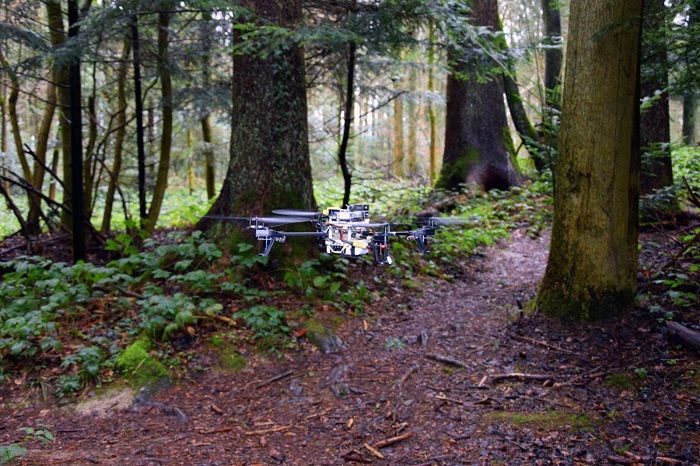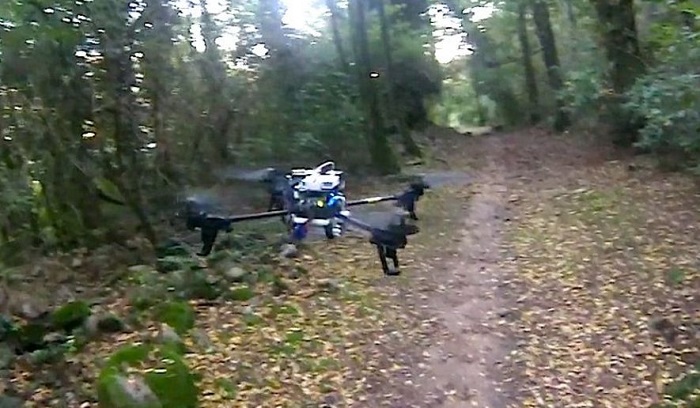Small quadcopters have been updated with specially designed artificial intelligence software to teach the drone how to autonomously locate missing persons.

The technology, developed by researchers from the Dalle Molle Institute for Artificial Intelligence and the University of Zurich, is meant to assist rescue teams searching for missing hikers in mountains and forested areas. When deployed in large numbers, it is believed this aerial approach to search and rescue will greatly reduce response time and risk of injury to the missing person(s) and rescue team(s) alike.

“While drones flying at high altitudes are already being used commercially, drones cannot yet fly autonomously in complex environments, such as dense forests. In these environments, any little error may result in a crash, and robots need a powerful brain in order to make sense of the complex world around them,” says Professor Davide Scaramuzza from the University of Zurich.
The updated drone was equipped with a pair of small cameras (like those found in smartphones) but rather than rely on sensors alone, it was also programmed with a collection of very power artificial intelligence algorithms designed to interpret images of the location below, for the purpose of determining where man-made trails are located. If a trail is visible, the program instructs the drone to follow it.
“Interpreting an image taken in a complex environment such as a forest is incredibly difficult for a computer,” says Dr. Alessandro Giusti from the Dalle Molle Institute for Artificial Intelligence. “Sometimes even humans struggle to find the trail!”
The team was able to overcome this hurdle using what’s referred to as Deep Neural Network — a computer algorithm that learns to solve complex tasks from a collection of “training examples”; similar to how a brain learns from experience. To gather enough image data to train the algorithms, the team hiked for several hours along trails in the Swiss Alps. During this time, cameras attached to their helmets captured 20,000 images.
Fortunately, the effort worked: when the image data was upload to the algorithms and tested out by a drone flying above a new, never-before-flown-above trail, the Deep Neural Network correctly identified the correct direction 85% of the time; in comparison, when humans were face with the same task, they guessed correctly 82% of the time.
“Our lab has been working on deep learning in neural networks since the early 1990s,” explains Professor Juergen Schmidhuber, Scientific Director at the Dalle Molle Institute for Artificial Intelligence. “Today I am happy to find our lab's methods not only in numerous real-world applications such as speech recognition on smartphones, but also in lightweight robots such as drones. Robotics will see an explosion of applications of deep neural networks in coming years.”
Along with the announcement, the team had to state an obvious disclaimer about the technology: there’s still a lot of work that needs to be done before an autonomous fleet of drones can be deployed to locate a missing person in the woods.
“Many technological issues must be overcome before the most ambitious applications can become a reality,” said Professor Luca Maria Gambardella, director of the Dalle Molle Institute for Artificial Intelligence in Lugano. “But small flying robots are incredibly versatile, and the field is advancing at an unseen pace. One day robots will work side by side with human rescuers to make our lives safer.”
“Now that our drones have learned to recognize and follow forest trails, we must teach them to recognize humans,” adds Professor Davide Scaramuzza from the University of Zurich.
To see the drone in action, check out the clip below:
To learn more about artificially intelligent rescue drones, download the team’s paper entitled A Machine Learning Approach to Visual Perception of Forest Trails for Mobile Robots.
Advertisement
Learn more about Electronic Products Magazine





